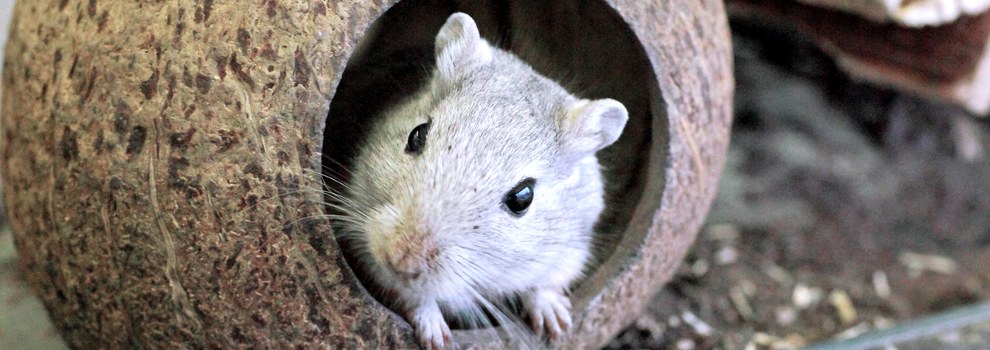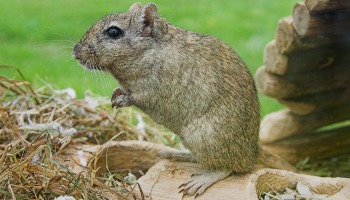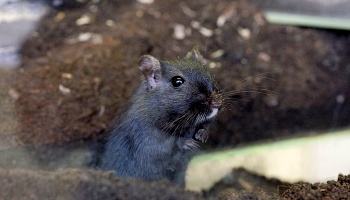Gerbil housing
Wild gerbils live in dry climates, in large, deep burrows that they dig to protect themselves from extremes of weather and from predators. Gerbils have fur on the soles of their feet and so don't climb well.
Your gerbils' housing needs:
- Enough space - gerbils should have a special gerbilarium, which should be large enough to provide shelter, opportunities to dig and space to exercise. It should have solid glass walls, a secure wire-mesh top and a solid floor to allow for bedding material to be provided (to absorb the relatively small quantities of urine they produce and to allow for digging). Cages with metal bars are not recommended as gerbils may slip and injure their legs or feet, and gnaw on the bars which can damage their teeth.
- Nesting and bedding materials - gerbils naturally build nests.
- A rough-surfaced object, such as a stone, to help wear down their claws and give further structure to their burrows. These also provide suitable places for scent-marking. Gerbils' claws need to be worn down through regular digging or walking on rough surfaces, or they may grow too long.
-
If you already keep your gerbils in a cage, and your gerbils spend a lot of time repetitively digging in one corner, provide additional enrichment and hiding places and consider moving them to a gerbilarium with added depth so they can create their own shelters.
- Suitable enrichment to reduce the risk of boredom.
Keeping your gerbils' home comfortable
Make sure your gerbils' home (and anywhere else they're left) is always comfortable for them by remembering to make sure it's:
- Indoors, comfortable, dry and draught-free – make sure they're not exposed to draughty or damp conditions, but also don't keep them in direct sunlight or next to a radiator.
- The right temperature - an ideal temperature range is 20-24°C.
- Quiet - gerbils communicate using ultrasonic frequencies, so they're sensitive to some sounds that we can't hear. Keep your gerbils' home away from things that can generate ultrasound, such as televisions, computer screens, vacuum cleaners or sources of running water.
- Cleaned regularly - deep-clean the gerbilarium every two to three weeks, and prevent the bedding material from becoming soiled, damp and smelly by removing faeces and uneaten food every few days.
- Familiar-smelling - gerbils have an acute sense of smell, so cleaning can be stressful for them and removing all odours may trigger fighting. Keep and reuse a small amount of used but unsoiled bedding and nesting material when you clean out your gerbilarium. Remove gerbils for the duration of cleaning.
Bedding material
Your gerbilarium should have a layer of suitable bedding material that’s deep enough to allow your gerbils to dig and construct a system of burrows.
- A bedding depth of 20-30cm is recommended. The gerbilarium should ideally be around 50cm high to allow your gerbils to dig and still have room to emerge above ground and stand fully upright (an adult gerbil is approximately 12cm tall).
- Suitable bedding substrate is a mix of rough-grained woodchips and hay – it will provide structure to their burrows and give them something to gnaw too.
-
Non-toxic peat may be suitable though it is not environmentally friendly. Soil from your garden is not recommended as it may contain harmful bacteria or parasites. Don’t use sawdust, as it may cause respiratory problems.
Nesting material
Make sure your gerbils always have access to appropriate nesting material that they can shred.
- Gerbils are highly motivated to shred gnawable material such as ink-free cardboard or paper and hay. Empty toilet rolls, egg containers or plain cardboard boxes are also ideal.
-
Don’t provide nesting materials that can separate into thin strands such as cotton wool or similar ‘fluffy’ bedding products. They pose a serious risk to the welfare of your pet.
Hiding places
As well as the opportunity to dig their own shelters, your gerbils should have a suitable place to hide.
- Provide a dark nesting box large that your gerbils can use to set up a food store, to sleep, and to comfortably move around.
- It should ideally have multiple entrances to avoid dominant animals trapping others inside and preventing others from entering. An entrance via an angled tube will prevent light entering the shelter too.
-
Apart from the nesting box, provide gerbils with other hiding areas. The number of those should exceed the number of gerbils by one.
Enrichment
Gerbils need enrichment to reduce the risk of boredom. Add some items like gnaw sticks, cardboard tubes and boxes to chew on, and wooden-based toys such as bridges, tunnels and logs which they can climb on top of, hide under, chew and explore.
You can also add an axle-free exercise/running wheel to help your gerbils get their daily exercise, but make sure it has a large diameter and solid structure so that your gerbils' feet or legs can't get trapped and injured.
Follow the links below to find out more about caring for your gerbils.




